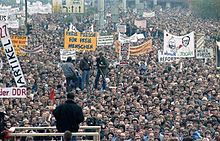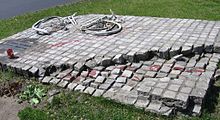Civil rights movements
A civil rights movement is a social movement that tries to enforce human and civil rights of groups in society that are oppressed, discriminated against or socially disadvantaged by prevailing politics . Historically exemplary and eponymous, sometimes also used synonymously , is the civil rights movement of African Americans in the United States of the 1950s and 1960s, the Civil Rights Movement .
United States

One of the historically best-known civil rights movements is the American Civil Rights Movement of African Americans , which through its popular protagonist Martin Luther King and the civil disobedience he propagated against the legally enshrined discrimination against the black population in the southern states of the USA during the late 1950s and 1960s Years of worldwide attention and importance.
Further civil rights movements in the USA
In the 1960s and 1970s in particular, other national or ethnic minorities in the United States took up demands of the African American Civil Rights Movement . This led to independent civil rights movements that defended themselves against racism or racist oppression and social disadvantage.
For example:
- The American Indian Movement - AIM - ( American Indian Movement ) as an organization of the indigenous people of the USA. The AIM campaigned for the rights of the American indigenous population - up to and including the demand for autonomous rights of self-determination for the Indians , sometimes with a status independent of the USA. This organization attracted worldwide attention, particularly in the early 1970s through militant resistance actions (see also the occupation of Wounded Knee 1973 ).
- The movement of the Mexican minority in the USA, the so-called Chicanos (the movement had demonstratively adopted the swear word originally used for its origin as its own name and used it as positive). This movement occurred mainly in the west (e.g. in California ) and the southwest of the USA and also fought for the equality of their population group with the other Americans (see also under History of the Mexican Americans ).
South Africa

Against the colonial and religiously declared racism and the apartheid ideology that emerged from it, a diverse civil rights movement grew up in South Africa . It was later collectively referred to as the anti-apartheid movement . A symbol of the resistance there was the civil rights activist and chairman of the ANC ( African National Congress ) Nelson Mandela . Imprisoned as a political prisoner from 1964 to 1990 , Mandela was eventually released from prison under pressure from an international public . After the state apartheid doctrine was repealed, Mandela received the Nobel Peace Prize together with then President Frederik Willem de Klerk in 1993 and became President of the Republic of South Africa himself after the parliamentary elections in 1994 . Other personalities who, through their family origins, represent the Indian , European and colored sections of the population, had taken leading roles in civil rights activities aimed at establishing equal civil rights.
Europe
There were and are various civil rights movements in Europe too . You stand up for the rights of minorities and / or disadvantaged population groups . During the time of socialism / communism they fought for the observance of human and civil rights in the respective countries.
Northern Ireland
In Northern Ireland she works for the equality of the Catholic minority .
Eastern bloc during the Cold War
In the 1970s and 1980s, various opposition groups emerged in the Eastern European communist states of the Warsaw Pact , which, citing the CSCE Final Act of Helsinki 1975 , demanded the implementation of human and civil rights in what was then the Eastern Bloc .
Soviet Union
As early as the early 1960s, some writers and scholars who were critical of the system in the Soviet Union turned against censorship , for example by illegally self-publishing their works ( samizdat ). Well-known intellectual civil rights activists were, for example, the writer Alexander Solzhenitsyn and the scientist Andrei Sakharov . Solzhenitsyn became known for his books The First Circle of Hell , A Day in the Life of Ivan Denisovich and, above all, The Gulag Archipelago .
Czechoslovakia and Czech Republic
In Czechoslovakia , the civil rights movement was initially eliminated after the Soviet Union's violent suppression of the reform communist Prague Spring in 1968. However, in 1977 a Czechoslovak group published Charter 77 , which again formulated demands for reform in the spirit of the civil rights movement. One of the spokesmen for Charter 77 was the writer Václav Havel , who was elected President of the Czech Republic after the collapse of the Communist Eastern Bloc .
Poland
In Poland , the establishment of the independent trade union Solidarność in 1980 ( banned under martial law in 1981 , re-authorized in 1989) marked the beginning of the demise of the local communist system. Its chairman, Lech Wałęsa , was elected President of Poland in 1990.
GDR

In addition to other communist Eastern Bloc states , a number of prominent figures in the GDR, such as the scientist and reform communist Robert Havemann , who had to live in house arrest for years , or the songwriter Wolf Biermann , who was denied re-entry into the GDR in 1976, stood for the goals of the civil rights movement and called for an end to the suppression of civil rights in the GDR.
In detail, civil rights activists and human rights organizations blamed the GDR leadership and the members of the nomenklatura for the following:
Domestic policy:
- Establishment of a dictatorship and denial of democracy for the population
- Denial of free elections
- Denial of freedom of movement , freedom of expression , freedom of the press , the right to strike and to demonstrate
- Disregard of the secrecy of letters and telecommunications
- party-dependent law and ideological political criminal law
- about 180,000 political prisoners (of which approximately 32,000 by the Federal Republic of Germany from 1964 to 1989 ransomed )
- open and hidden forced labor
- Deprivation of property
- various falsification of history
- Prevention of freedom of teaching and research
- ideological orientation of all public life and the education system
Foreign policy:
- Construction of the wall : restriction of freedom of movement for GDR citizens.
- Order to shoot : Around 200 refugees were killed by gunfire and mines , another 800 were killed, frozen to death and drowned while trying to escape from the GDR .
Critics who publicly mentioned, discussed or disseminated these points in the GDR ran the risk of being discovered by recruited informers or Stasi employees and handed over to the GDR judiciary . Banal citations or criticism of the GDR's dependence on the Soviet Union usually led to interrogations and questioning. The occupation of the areas of responsibility with nomenklatura members prevented a mention of the above points and a discussion of these topics in the media , art and literature .
At the end of 1989, after numerous demonstrations (see also Monday demonstrations ), the Berlin Wall fell . The events led in 1990 to the fall of the SED - regime and to the reunification of Germany .
Romania
In the late 1980s, voices were also raised in Romania calling for a democratic form of government , human and civil rights and economic reforms. The situation in Romania at that time, especially in connection with the supply situation, was described by some political observers as grotesque: It was criticized that the high party officials lived in luxury, while a large part of the simple population often looked for bread and chicken bones (in the vernacular "cutlery "called) decency. Political opponents were arrested, interrogated or "disappeared" in psychiatric hospitals . Unwanted, “surplus” and handicapped children were often put in children's homes , which some have compared to the conditions in concentration camps ( see also : Cighid ). Abortion was punishable by severe penalties, since the regime ruthlessly wanted to enforce its policy of “national population growth” .
The close network of informers and collaborators , the state surveillance and the omnipresence of the secret police Securitate made the establishment of an organized democracy movement much more difficult. In the last years of the 1980s, opposition members gathered around Pastor Laszlo Tökes , who became a symbol of the revolution. In late 1989, it came to Timisoara to demonstrations against the communist regime. Something similar happened in other cities. The police and the Securitate initially put down the uprisings quickly, but were unable to stop the democracy movement from taking hold in the long term. During the revolutionary unrest it turned out that all of Bucharest was tunnelled and criss-crossed with bunkers for the secret police. In December 1989, the dictator Nicolae Ceaușescu was overthrown and sentenced in an express trial before he was shot together with his wife Elena Ceaușescu shortly afterwards .
People's Republic of China

In the People's Republic of China , from the mid-1980s, a civil rights movement ( democracy movement ) supported primarily by students , which demanded more freedom and democratic reforms through demonstrations and wall newspapers . Despite repeated calls by the government to end the demonstrations, they continued to gain popularity. In 1989, around 100,000 students and workers gathered in Tian'anmen Square in Beijing to emphasize calls for more democracy. The place was eventually evacuated using massive military force . Around 1,000 demonstrators were killed. Thousands more were injured. This suppression of the Chinese civil rights movement was followed by a phase of political repression in China lasting several years , which has prevented the democratic movement from flaring up again to date.
Individual evidence
- ↑ UC: GDR forced laborers are also demanding compensation. In: welt.de . August 19, 2001. Retrieved October 7, 2018 .
- ↑ http://einestages.spiegel.de/static/authoralbumbackground/9381/_die_wende_in_mir.html
- ↑ http://www.tagesspiegel.de/politik/zwangsarbeit-ddr-haeftlinge-mussten-fuer-ikea-schuften/6586614.html